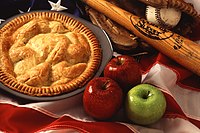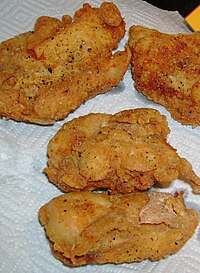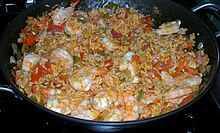Cuisine of the Southern United States
This article needs additional citations for verification. (September 2011) |
| Part of a series on |
| American cuisine |
|---|
 |


The cuisine of the Southern United States is the historical regional culinary form of states generally south of the Mason–Dixon line dividing Pennsylvania and Delaware from Maryland as well as along the Ohio River, and extending west to southern Missouri, Oklahoma and Texas.
The most notable influences come from African, English, Scottish, Irish, French, and Native American cuisines. Tidewater, Appalachian, Creole, Lowcountry, and Floribbean are examples of types of Southern cuisine. In recent history, elements of Southern cuisine have spread north, having an effect on the development of other types of American cuisine.
Many elements of Southern cooking—squash, tomatoes, corn (and its derivatives, including grits), and deep-pit barbecuing—are borrowings from southeast American Indian tribes such as the Caddo, Choctaw, and Seminole. Sugar, flour, milk, and eggs come from Europe; the Southern fondness for fried foods is Scottish, and the old-fashioned Virginian use of ragouts comes from the West Country of England. Black-eyed peas, okra, rice, eggplant, benne (sesame) seed, sorghum, and melons, as well as most spices used in the South, are originally African; a preponderance of slaves imported to Virginia in early years were Igbo from the Bight of Biafra,[3] and down to the present day Southern and Nigerian cuisines have many flavors and elements in common.
The South's fondness for a full breakfast (as opposed to a Continental one with a simple bread item and drink) derives from the British full breakfast or fry-up, variously known as the full English breakfast, full Scottish, full Irish, full Welsh, and Ulster Fry. Many Southern foodways, especially in Appalachia, are Scottish or Border meals adapted to the new subtropical climate; pork, informally taboo in Scotland, takes the place of lamb and mutton, and instead of chopped oats, Southerners eat chopped hominy (although oatmeal is much more common now than it once was).
Parts of the South have other cuisines, though. Creole cuisine is mostly vernacular French, West African and Spanish; Floribbean cuisine is Spanish-based with obvious Caribbean influences; and Tex-Mex has considerable Mexican and Native American influences.
Traditional Southern dishes

A traditional Southern meal is pan-fried chicken, field peas (such as black-eyed peas), greens (such as collard greens, mustard greens, turnip greens, or poke salad), mashed potatoes, cornbread or corn pone, sweet tea, and dessert—typically a pie (sweet potato, chess, shoofly, pecan, and peach are the most common), or a cobbler (peach, blackberry, sometimes apple in Kentucky or Appalachia).
Other Southern foods include grits, country ham, hushpuppies, beignets, Southern styles of succotash, chicken fried steak, buttermilk biscuits (may be served with butter, jelly, fruit preserves, honey, gravy or sorghum molasses), pimento cheese, boiled or baked sweet potatoes, pit barbecue (especially ribs), fried catfish, fried green tomatoes, bread pudding, okra (fried, steamed, stewed, sauteed, or pickled), butter beans, pinto beans, and black-eyed peas.
Fried chicken is among the region's best-known exports. It is believed that the Scots, and later Scottish immigrants to many southern states had a tradition of deep frying chicken in fat, unlike their English counterparts who baked or boiled chicken.[4][5][6] Pork is an integral part of the cuisine. Stuffed ham is served in Southern Maryland.[7] A traditional holiday get-together featuring whole hog barbecue is known in Virginia and the Carolinas as a "pig pickin'". Green beans are often flavored with bacon and salt pork, turnip greens are stewed with pork and served with vinegar, ham biscuits (biscuits cut in half with slices of salt ham served between the halves) often accompany breakfast, and ham with red-eye gravy or country gravy is a common dinner dish.[citation needed]
Southern meals, especially among the poor of both races (and historically among slaves), sometimes consist only of vegetables, with a little meat (especially salt pork) used in cooking but with no meat dish served. "Beans and greens"—white or brown beans served alongside a "mess" of greens stewed with a little bacon—is a traditional meal in many parts of the South. (Turnip greens are the typical greens for such a meal; they're cooked with some diced turnip and a piece of fatback.) Other low-meat Southern meals include beans and cornbread—the beans being pinto beans stewed with ham or bacon—and Hoppin' John (black-eyed peas, rice, onions, red or green pepper, and bacon).
Coleslaw is also popular, both as a side dish and on a variety of barbecued and fried meats.[8] Apart from it, though, Southern cooking makes little use of cabbage.
Southern food in restaurants


Chains serving Southern foods—often along with American comfort food—have had great success; many have spread across the country (or across the world), while others have chosen to stay in the South. Pit barbecue is popular all over the American South; unlike the rest of the country, most of the rural South has locally owned, non-franchise pit-barbecue restaurants, many serving the regional style of barbecue instead of the nationally-predominant Kansas City style. Family-style restaurants serving Southern cuisine are common throughout the South, and range from the humble and down-home to the decidedly upscale.
Southern cuisine by region
Southern cuisine varies widely by region:
- In Southern Louisiana, there is Creole cuisine. Louisiana is the largest supplier of crawfish in the U.S.[9]
- In the coastal areas of South Carolina, rice was an important crop, leading to local specialties like "Hoppin' John" (a mixture of rice and Black-eyed peas flavored with salt pork) and Charleston Red Rice.
- Arkansas produces Riceland rice and sweet corn, both of which are staples of the cuisine of Southeastern Arkansas.[citation needed]
- Virginia produces Smithfield ham.[10]
- Mississippi and Alabama produce the most catfish in the United States.[11]
Oklahoma has a reputation for many grain- and bean-based dishes, such as "cornbread and beans" or the breakfast dish biscuits and gravy. Mississippi specializes in farm-raised catfish, found in traditional "fish houses" throughout the state. Arkansas is the top rice-producing state in the nation, and is also noted for catfish, pork barbecue at restaurants, and chicken. Tennessee is known for its country ham and Memphis, TN is known for several famous barbecue restaurants and a major barbecue cooking competition held in May. Maryland is known for its blue and soft-shell crabs, and Smith Island Cake. Florida is home of the Key lime pie and swamp cabbage. Orange juice is the well-known beverage of the state. Georgia is known for its peaches, pecans, peanuts and Vidalia onions.[citation needed]
The Appalachian areas have ramps (onions and their relatives) and berries aplenty. Kentucky is famous for Burgoo and beer cheese. Texas specializes in barbecue and chili as well as a regional variation of Mexican food unique to Texas called Tex-Mex. Brunswick stew, which originated in the town of Brunswick, Georgia, is also popular.
Generally speaking, the Upper South favors pork, sorghum, and whiskey; the Low Country (the coast, especially coastal Georgia and coastal South Carolina) favors seafood, rice, and grits. Appalachia uses butter extensively but makes little use of cheese, and eats more wild game (as well as wild fruits and vegetables) than the rest of the South; apples, oats, and potatoes are also common in Appalachian cuisine, since the mountains are cooler and drier than the lowlands. Texas and Oklahoma, where the South shades into the Great Plains, tend to eat beef; the rest of the South (including Arkansas, which is geologically more like Appalachia than anything) prefers pork.[citation needed]
Louisiana Creole cuisine

Southern Louisiana is geographically and politically part of the South, but its cuisine is probably best understood as having only mild Southern influences. (Cajuns even prefer unsweetened tea) Creole cuisine makes good use of many coastal animals—crawfish (commonly called crayfish outside the region), crab, oysters, shrimp, and saltwater fish—along with figs (unknown in Southern cooking), and plums and grapes (both very rare, except for use of prunes as medicine). Pecans and peanuts also flourish in Louisiana, and are used more extensively than they are elsewhere in the South. Chicory coffee is sometimes preferred over the real thing—especially as an accompaniment to beignets.

Lowcountry cuisine
The Lowcountry region of the coastal Carolinas, Virginia, and Georgia shares many of the same food resources as the Upper Gulf Coast: fish, shrimp, oysters, rice, and okra. It also displays some similarities to Creole and Cajun cuisines.[citation needed]
Appalachian cuisine
Travel distances, conditions, and poor roads limited most early settlements to foods that could be produced locally. For farmers, pigs and chickens were the primary source of meat, with many farmers maintaining their own smokehouses to produce a variety of hams, bacon, and sausages. Seafood, beyond the occasionally locally caught fish (pan-fried catfish is much loved) and crawfish, were unavailable until modern times. However, Appalachia did offer a wide variety of wild game, with venison and squirrel particularly common, thus helping compensate for distance from major cities and transportation networks. The popularity of hunting and fishing in Appalachia means that game and fish are often staples of the table. Deer, wild turkey, grouse and other game birds are hunted and utilized in many recipes from barbecue to curing and jerky.[15]
As wheat flour and baking powder/baking soda became available in the late 19th century, buttermilk biscuits became popular; formerly, cornbread was the most common bread in the mountains. Salt, a necessity for life, was always available (much of it coming from Saltville, Virginia), and local seasonings like spicebush were certainly known and used; but the only other seasonings used in the mountains are black pepper and flaked red pepper, along with a little use of cinnamon, nutmeg, and cloves around Christmas. Coffee, drunk without milk and only lightly sweetened, is a basic drink in Appalachia, often consumed with every meal; in wartime, chicory is widely used as a coffee substitute.
Today, buttermilk biscuits and sausage gravy are the classic Appalachian breakfast; they're also a common breakfast everywhere where Appalachian people have emigrated. Both North Carolina and West Virginia have statewide biscuit chain restaurants;[16] many Southern or originally-Southern chains offer biscuits and gravy, and when McDonald's introduced a new breakfast menu selling either Egg McMuffins (with English muffins) or a variant with biscuits, the biscuit zone was practically a map of the South.[17]
The gravy for biscuits and gravy is typically sausage or sawmill, not the red-eye gravy (made with coffee) used in the lowland South. Pork drippings from frying sausage, bacon, and other types of pan-fried pork are collected and saved, used for making gravy and in greasing cast-iron cookware. (Note that Appalachia is overwhelmingly Protestant, the Catholic prohibition on meat-eating during Lent had no impact on Appalachian cuisine.) Chicken and dumplings and fried chicken remain much-loved dishes. Cornbread, corn pone, hominy grits, mush, cornbread pudding and hominy stew are also quite common foods, as corn is the primary grain grown in the Appalachian hills and mountains, but are less common than in the past.
In contrast to the lowlands, where sugar cane molasses was the usual sweetener, Appalachia mainly used sorghum and honey. European fruits—especially apples and pears—can grow in the mountains, and sweet fried apples are a common side dish. Appalachian cuisine also makes use of berries, both native and European, and some parts of the mountains are high enough or far enough north that sugar maple grows there—allowing for maple syrup and maple sugar production. Wild morel mushrooms and ramps (similar to scallions and leeks) are often collected; there are even festivals dedicated to ramps, and they figure in some Appalachian fairy tales.
Home canning, of both garden and foraged foods, is a strong tradition here as well; mason jars are an everyday sight in mountain life; the most common canned foods are savory vegetables: green beans (half-runners, snaps), shelly beans (green beans that were more mature and had ripe beans along with the green husks), and tomatoes. Dried pinto beans are a major staple food during the winter months, used to make the ubiquitous ham-flavored bean soup usually called soup beans. Kieffer pears and apple varietals are used to make pear butter and apple butter. Also popular are bread and butter pickles, fried mustard greens with vinegar, pickled beets, chow-chow (commonly called "chow") and a relish called corn ketchup. fried green tomatoes are a common food, but basically unknown outside of the mountains; tomatoes are also used in tomato gravy, a variant of sausage gravy with a thinner, lighter roux. A variety of wild fruits like pawpaws, wild blackberries, and persimmons are also commonly available in Appalachia as well.[citation needed]
See also
- Barbecue
- Cuisine of the Southwestern United States
- Cuisine of the United States
- Liberian cuisine
- Soul food
- Southern Food and Beverage Museum
- Tex-Mex cuisine
Notes
- ^ David Williamson. "UNC-CH surveys reveal where the 'real' South lies". Retrieved 22 February 2007.
- ^ "Archived copy". Archived from the original on 2007-08-09. Retrieved 2007-03-18.
{{cite web}}: Unknown parameter|deadurl=ignored (|url-status=suggested) (help)CS1 maint: archived copy as title (link) - ^ Fischer, David Hackett; Kelly, James C. (2 February 2016). "Migration to Virginia". Bound Away: Virginia and the Westward Movement. University of Virginia Press. p. 60. ISBN 978-0-8139-1774-0.
- ^ "Southern fried". Enquirer.com. Retrieved 2009-06-20.
- ^ "Southern favorites". Southernliving.com. Retrieved 2016-01-05.
- ^ Lynne Olver. "history notes-meat". The Food Timeline. Retrieved 2009-06-20.
- ^ Gray, Mary Z. (5 December 1982). "Stuffed Ham With A Kick". The New York Times. Retrieved 31 July 2012.
- ^ Villas, James. The Glory of Southern Cooking", John Wiley & Sons, Hoboken, NJ, 2007, pg. 73
- ^ Thier, Dave (December 5, 2012). "In Louisiana, Growing Rice to Trade on Some Creatures That Eat It". The New York Times. New York City. Retrieved July 10, 2016.
- ^ LIS > Code of Virginia > 3.2-5419
- ^ "Alabama Catfish Producers | Alabama Farmers Federation | ALFA Farmers Federation". alfafarmers.org. Retrieved 2016-08-11.
- ^ Brasseaux, Ryan A.; Brasseaux, Carl A. (1 February 2014). "Jambalaya". In Edge, John T. (ed.). The New Encyclopedia of Southern Culture: Volume 7: Foodways. University of North Carolina Press. p. 188. ISBN 978-1-4696-1652-0.
- ^ Anderson, E. N. (7 February 2014). Everyone Eats: Understanding Food and Culture, Second Edition. NYU Press. p. 106. ISBN 978-0-8147-8916-2.
- ^ Davidson, Alan (11 August 2014). "Jollof rice". The Oxford Companion to Food. Oxford University Press. p. 434. ISBN 978-0-19-967733-7.
- ^ Abramson, Rudy and Jean Kaskell (eds.), Encyclopedia of Appalachia, Univ. of Tennessee Press, Knoxville, TN, 2006 pgs. 917, 955,1387-1389
- ^ G&G's Fast-Food Breakfast Biscuit Taste Test
- ^ Map: McDonald's all-day breakfast pits muffins against biscuits
References
- Bowen, Carl. Southern-Recipes. 2010. ISBN 978-1-4563-4479-5.
- Domine, David. 111 Fabulous Food Finds: Best Bites in the Bluegrass. McClanahan Publishing House, 2011. ISBN 978-1-934898-12-3.
- Domine, David. Adventures in New Kentucky Cooking with the Bluegrass Peasant. McClanahan Publishing House, 2007. ISBN 0-913383-97-X.
- Domine, David. Splash of Bourbon, Kentucky's Spirit. McClanahan Publishing House, 2010. ISBN 978-1-934898-06-2
- Harris, Jessica. On the Side: More than 100 Recipes for the Sides, Salads, and Condiments That Make the Meal. Simon & Schuster, 2004. ISBN 0-7432-4917-8.
- The Junior League of Charleston. Charleston Receipts. Wimmer Brothers, 1950. ISBN 0-9607854-5-0.
- Lewis, Edna and Peacock, Scott. The Gift of Southern Cooking: Recipes and Revelations from Two Great American Cook. Knopf, 2003. ISBN 0-375-40035-4.
- Neal, Bill. Bill Neal's Southern Cooking. University of North Carolina Press, 1989. ISBN 0-8078-4255-9.
- Neal, Bill. Biscuits, Spoonbread, and Sweet Potato Pie. University of North Carolina Press, 2003. ISBN 0-8078-5474-3.
- Neal, Bill. Good Old Grits Cookbook. Workman Publishing Company, 1991. ISBN 0-89480-865-6.
- Snow, Constance. Gulf Coast Kitchens. Clarkson Potter/Publishers, 2003. ISBN 0-609-61011-2.
- Sohn, Mark F. Appalachian Home Cooking History, Culture, & Recipes Lexington: University Press of Kentucky. 2005. ISBN 0-8131-9153-X
- Taylor, John. Hoppin' John's Lowcountry Cooking. 1992. ISBN 0-553-08231-0.
- Walter, Eugene. American Cooking: Southern Style. New York: Time Life Books, 1971.
Further reading
- Edge, John T., ed. (2007). The New Encyclopedia of Southern Culture Volume 7: Foodways. University of North Carolina Press. ISBN 978-0-8078-5840-0. JSTOR 10.5149/9781469616520_edge.
- Ferris, Marcie Cohen (2014). The Edible South: The Power of Food and the Making of an American Region. Chapel Hill, NC: University of North Carolina Press.
